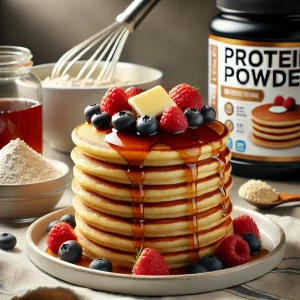Overnight oats have become a go-to for many busy individuals seeking a quick, nutritious breakfast. Blended overnight oats offer a smooth, creamy texture that some people find more enjoyable than the traditional chunky version. But is it okay to blend overnight oats, and what happens to their nutritional benefits when you do?
The Concept of Blended Overnight Oats
Blending overnight oats involves soaking the oats overnight and blending them in the morning for a smoother consistency. The resulting mixture is creamy and drinkable, making it an ideal choice for those who prefer a more seamless eating experience.
If you’re interested in learning more about other quick breakfast options, you can check out best healthy filling breakfast ideas, which are perfect for those who want variety in their morning routine.
Why Blending Overnight Oats is Becoming Popular
Blending oats offers a range of benefits, particularly for those who prefer a smoothie-like consistency over the traditional chewy texture of overnight oats. Here are some reasons why blending is gaining popularity:
- Creamy texture: Blending breaks down the oats, creating a smoother, pudding-like consistency.
- Quick and easy consumption: Perfect for those who prefer drinking their breakfast or are short on time.
- Easier digestion: Blended oats can be easier to digest for those with sensitive stomachs.
For those who enjoy creamy breakfast options, you may also enjoy other soft-textured meals like breakfast toast ideas, which pair well with blended oats.
Is it Okay to Blend Overnight Oats?
Yes, it’s completely fine to blend overnight oats. Whether you blend them or eat them as is, oats retain their nutritional benefits. However, blending may slightly affect the fiber content, as breaking down the oats can reduce their fibrous structure. To compensate, you can add chia seeds or flaxseeds after blending to boost the fiber content.
Blending Benefits:
- Smooth texture: Ideal for people who dislike the traditional chewy texture of oats.
- Easier on digestion: Blended oats are softer and easier to process for those with digestive concerns.
If you’re interested in making your breakfasts both nutritious and delicious, consider exploring healthy green juice recipes to complement your oats.
Nutritional Benefits of Overnight Oats
Overnight oats, whether blended or not, are packed with fiber, protein, and essential nutrients. They provide slow-releasing energy and support digestion. Here’s what makes overnight oats a powerhouse breakfast:
- High fiber content: Supports gut health and helps regulate blood sugar.
- Rich in antioxidants: Oats contain important antioxidants that reduce inflammation.
- Customizable: You can add nutrient-dense ingredients like chia seeds, plant-based milk, and fresh fruits.
Looking for more ideas on how to enhance the nutritional profile of your oats? Try adding fruits like berries, bananas, or apples for natural sweetness and an antioxidant boost.
Does Blending Affect Nutritional Value?
Blending overnight oats does not significantly alter their nutritional value. However, breaking down the oats’ structure may impact the fiber content. If you’re concerned about fiber loss, you can:
- Add chia seeds, flaxseeds, or other high-fiber ingredients after blending.
- Include whole fruits to maintain some of the fiber benefits.
This way, you can still enjoy the creamy texture while getting a balanced meal.
The Importance of Soaking Oats
Soaking oats overnight is essential for breaking down phytic acid, a compound that can interfere with nutrient absorption. Soaking also softens the oats, making them easier to digest and blend into a creamy mixture. By soaking your oats overnight, you ensure that the nutrients are more bioavailable, meaning your body can absorb them more efficiently.
For a smoother morning routine, blended overnight oats are an excellent option, offering the benefits of soaked oats with a texture that’s easy to enjoy on the go.
Customizing Blended Overnight Oats for Optimal Nutrition
One of the best things about blended oats is how versatile they are. You can customize them to suit your nutritional needs and taste preferences. Here are some ideas:
- Protein boost: Add a scoop of protein powder or a tablespoon of almond butter.
- Healthy fats: Include chia seeds, flaxseeds, or a drizzle of coconut oil for added fats.
- Flavors: Enhance the taste with cinnamon, cacao powder, or vanilla extract.
Experiment with seasonal ingredients like pumpkin spice in the fall or tropical fruits in the summer to keep things fresh.
FAQs
Can I blend overnight oats the night before?
Yes, blending the oats the night before is convenient and saves time. However, blending them just before eating ensures the freshest texture.
Does blending overnight oats reduce fiber content?
Blending can break down some of the fiber, but adding chia seeds or flaxseeds after blending helps maintain fiber content.
Are blended overnight oats easier to digest?
Yes, blending oats can make them easier to digest, especially for those with sensitive stomachs or digestion issues.
Can I heat blended overnight oats?
Yes, you can heat blended oats after blending if you prefer a warm breakfast. Simply heat them in the microwave or on the stovetop.
What type of oats should I use for blending?
Rolled oats are the best option for blending because they soak well and result in a creamy, smooth texture after blending.
Blended overnight oats offer a smooth, creamy, and convenient breakfast option for busy mornings. Whether you prefer the traditional chunky texture or the smoother blended version, overnight oats remain a healthy, versatile breakfast choice. Be sure to explore more creative breakfast options like best toast toppings to add variety to your mornings.



